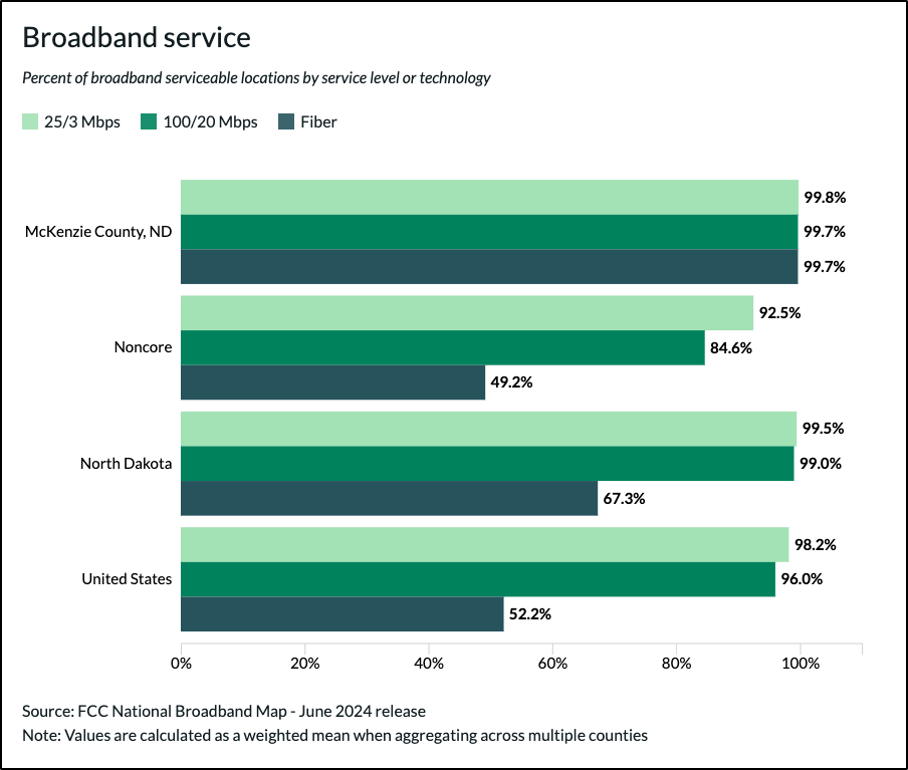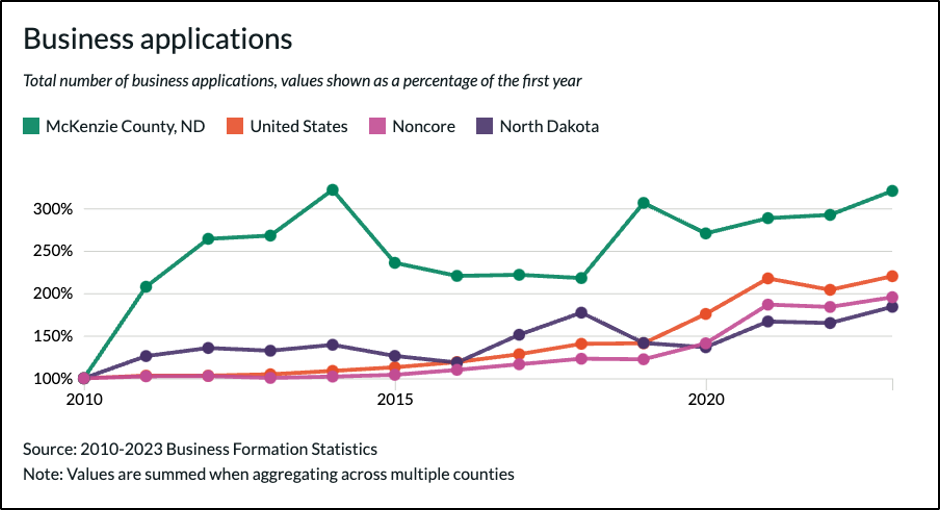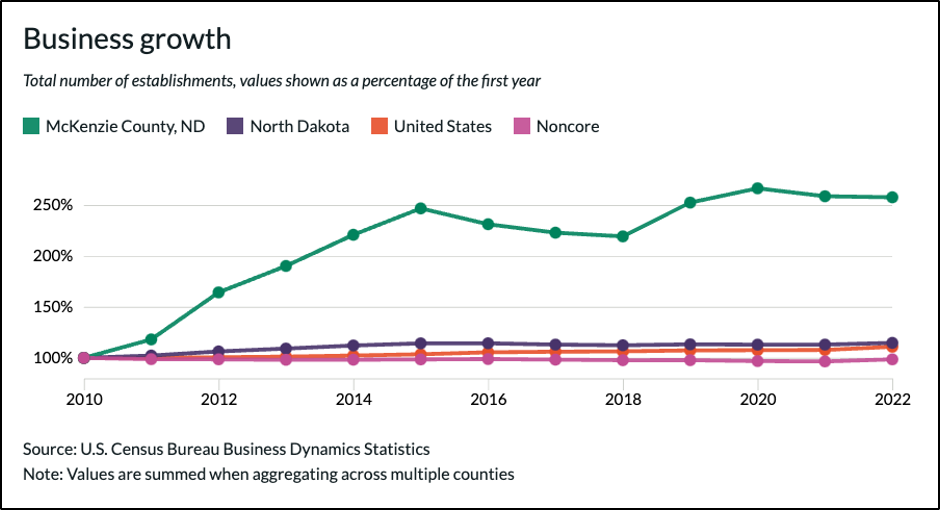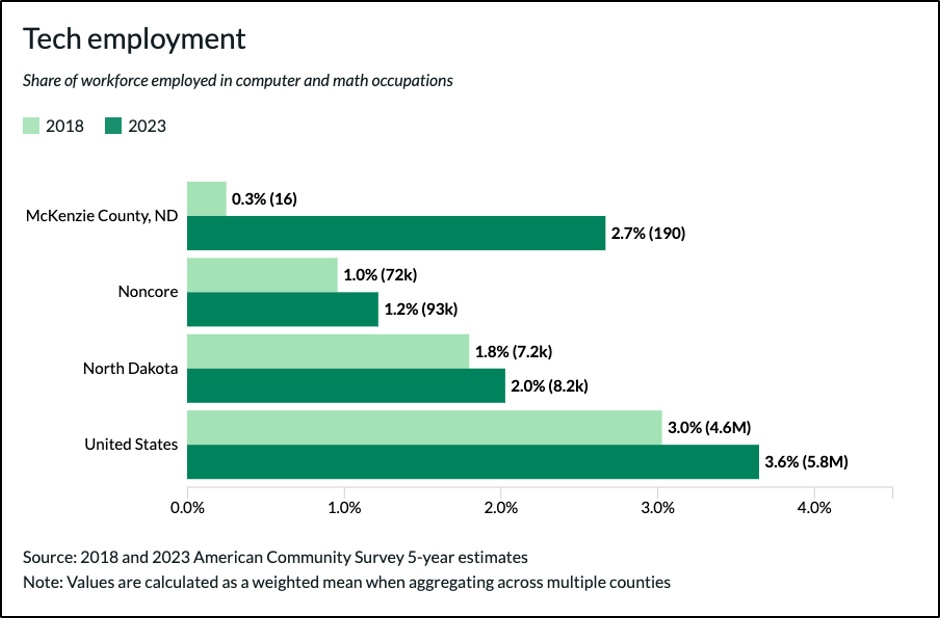Beyond Connectivity case study: McKenzie County, North Dakota
McKenzie County, in the heart of North Dakota’s Bakken oil patch, blends boomtown energy with rural resilience.
McKenzie County, in the heart of North Dakota’s Bakken oil patch, blends boomtown energy with rural resilience. With just under 15,000 residents and a labor force topping 10,000, it’s one of the fastest-growing rural counties in the state. While the oil and gas sector has driven much of that growth, any county that is reliant on a single industry carries a greater risk of disruption. That’s where RTC Networks comes in.
RTC Networks is a member-owned cooperative that invested early in fiber infrastructure, laying the foundation not just for connectivity for the oil and gas sector, but for broader economic diversification and entrepreneurship. Today, nearly every location in the county is fiber-connected. As a result, new businesses are taking root, remote work is growing, and tech-sector jobs are emerging, making McKenzie County more connected and resilient.
McKenzie is a remote county with sky-high economic activity and unique infrastructure challenges
Nestled among the prairies and badlands of western North Dakota, McKenzie County is one of the largest and fastest-growing counties in the state. Watford City, its county seat, has seen explosive growth in recent years, in large part due to oil and gas development. One community in the county ballooned from 1,500 to over 7,000 residents almost overnight during the oil boom. “When that happened, we had to meet the demand and build out the infrastructure – fast,” said Shane Hart, CEO and General Manager of RTC Networks.
The county’s labor force grew by nearly 500 workers between 2023 and 2024, unemployment remains below 1.5% — compared to the national rate of 4.1%, and taxable sales exceeded $87 million in Q3 of 2024.
Yet, this economic activity is taking place in an exceptionally rural setting. McKenzie County spans over 9,000 square miles and includes remote townships, tribal lands, and active farmlands. Private ISPs were not stepping in to connect the quickly growing population. “No one else wanted to serve this area,” Hart said.
The lack of service is what led to the creation of RTC more than 70 years ago. What started as a telephone cooperative, Reservation Telephone Cooperative (RTC Networks), has since evolved into a full-service broadband provider with 6,200 miles of fiber, 14,300 broadband customers, and a reputation for both technical excellence and community trust.
RTC Networks delivers near-universal fiber coverage, dramatically outperforming national benchmarks
McKenzie County is now among the most connected counties in the United States (rural or nonrural) and that’s almost exclusively because of RTC Networks. The cooperative made the strategic decision to invest in their community by providing fiber nearly 15 years ago and has since completed fiber buildouts across its service area, including in tribal lands in the community.
Figure 1 shows broadband service availability across different geographies. While 52.2% of locations in the U.S. have access to fiber, McKenzie County is almost fully covered, with fiber-optic broadband reaching 99.7% of locations. Access to speeds of 100/20 Mbps or higher is equally strong. These numbers dramatically outpace both state and national averages.
“Fiber is the infrastructure of choice for rural areas,” said Brooks Goodall, RTC Networks’ COO. “It’s not just about fast speeds — it’s about reliability, long-term value, and future-proofing our communities.” Fiber is more dependable than older technologies and can handle growing internet needs for many years without needing major upgrades.
Local ownership and broadband access fuel business development and regional expansion
High-speed fiber internet has connected McKenzie County and reshaped its economic possibilities. RTC Networks’ investments have helped unlock new business growth, supported remote work and education, and fueled healthcare expansion.
Figure 2 shows that the number of business applications in McKenzie County has grown over 300% since 2010. This trend signals a strong entrepreneurial environment, which research shows is accelerated by robust internet infrastructure (Center on Rural Innovation, 2024).
Local leaders credit RTC Networks’ fiber network as a foundational asset in McKenzie County’s growth, enabling the expansion of businesses and essential services. “We’ve had trucking companies, trade schools, oil support services, and new restaurants open up because they know they can count on fast, reliable internet,” explained Shane Hart. In some cases, businesses timed their openings to coincide with the completion of RTC Networks’ service installation, so they could launch with great broadband. “They were literally waiting on us,” Brooks Goodall noted, emphasizing how essential broadband access has become to local development.
Even traditional institutions like banks and hospitals have grown in tandem with RTC’s fiber build. “One of our hospitals was able to grow tremendously,” Hart noted. “They were able to hire more doctors, offer telemedicine, and even connect to specialists at the Mayo Clinic — all because of our fiber.”
Importantly, growing a world class healthcare system – as well as attracting skilled oil and gas employees – was made significantly easier with great broadband to every house (not just to the business district). RTC Networks’ connectivity creates a powerful recruitment advantage: when hospitals or energy companies bring in new hires, their partners can continue their careers remotely—eliminating a key relocation barrier for dual-income households. This has helped institutions like the local hospital attract top talent from across the region, knowing that entire families can thrive professionally in McKenzie County without sacrificing connectivity or opportunity.
Justin Voll, President of First International Bank and Trust (FIBT) and hospital board president, underscored this point: “There is no doubt that all the commercial and residential expansion that has taken place in Northwest North Dakota over the past 20 years would not have taken place without RTC. Many companies would have located elsewhere or expansions of existing business would not have happened without the services RTC provides.”
Between 2010 and 2022, the number of business establishments in McKenzie County increased by more than 150% — a growth rate far higher than the state and national averages, which remained flat during the same time period (see Figure 3).
This growth is supported not only by fast internet, but also by the local trust that RTC Networks has built. The cooperative is rooted in its community. Most of its employees live in the service area and several volunteer as firefighters or EMTs. That local presence means RTC is able to offer more than just connectivity — they offer dependable, personalized service.
As FIBT President Justin Voll put it, “Having RTC be a local business that provides the latest in technology and superior customer service is impossible to measure. RTC knows what the local customer base needs and wants and does a great job filling those needs.”
RTC Networks’ services go beyond fast connections – further juicing the local business environment
In addition to providing fast residential service, RTC Networks offers a suite of advanced technology solutions that rivals those of much larger providers. The cooperative supports small businesses with IT services, video-security systems, access control, and Calix-powered tools like SmartBiz—a managed Wi-Fi service that makes connectivity secure, scalable, and easy to manage.
RTC Networks’ technical capabilities are perhaps best exemplified by their work at the Rough Rider Center, a large, city-owned event and recreation facility in Watford City. RTC Networks designed and maintains the full networking infrastructure for the facility, including robust outdoor Wi-Fi for thousands of annual visitors. Similar public Wi-Fi services have been deployed at tribal casinos, campgrounds, and will soon expand to popular lakeside cabins.
RTC Networks also supports key community institutions like Wolf Pup Daycare, a state-of-the-art childcare center recognized across North Dakota. “RTC has played a huge role at Wolf Pup Daycare from the very beginning,” said Executive Director Tessa Moberg (pictured below). “We currently use RTC for our phone system, internet, camera system, and are in the beginning stages of using it for door access as well. That is huge for us because they are a phone call away when we have an issue and will be there to help within a day.” These services are not only critical for operations — they support the well-being of working families across the county.
Along with growth in new businesses, the types of work people in the county do has also changed with the deployment of better broadband. As shown in Figure 4, the share of McKenzie County’s workforce employed in computer and math occupations grew from 0.3% in 2018 to 2.7% in 2023. That’s a nearly tenfold jump in just five years, outpacing growth in peer counties, the state, and the nation. This trend highlights how strong digital infrastructure can create new opportunities in fields that were once rare in rural communities.
As highlighted in the Beyond Connectivity report from the Center on Rural Innovation, rural communities see the greatest economic benefits when high-quality infrastructure is paired with high rates of broadband adoption and a community-focused local service provider. McKenzie County is a powerful example. Thanks to near-universal fiber access and strong local engagement, broadband is being fully leveraged by residents, businesses, and institutions.
The growth in tech-sector jobs, remote work, and entrepreneurship reflects not just economic expansion, but greater economic resilience. By enabling more businesses and supporting a wider range of workers, especially those with transferable digital skills, RTC Networks’ investments are helping McKenzie County diversify its economy. These workers can move across industries, between local and remote opportunities, and adapt to shifting market demands, making the county more prepared for long-term change.
Community-first engagement and reinvestment strategies deepen RTC Networks’ local impact
RTC Networks’ board has prioritized ongoing reinvestment in the community. Their presence is felt in every part of the county, from tribal lands to local chambers of commerce.
The cooperative gives up to $40,000 in scholarships annually, sponsors a student trip to D.C. each year, and runs an “Operation Round Up” program that funds small-town nonprofits. Its marketing outreach is just as grassroots. RTC employees volunteer at food banks and sponsor popcorn nights at local football games, complete with branded seat cushions.
RTC Networks even built out fiber to one of the few one-room schoolhouses still in use after discovering that students lacked the reliable service needed to complete standardized testing. Now, they have what they need to succeed.
On the other end of the educational spectrum, the region’s Skills Center, which partners with the local high school to offer college credit and workforce training, also relies on RTC Networks’ connectivity. The center provides hands-on training in fields like healthcare, construction, and welding, preparing students for in-demand careers without having to leave the region. It’s a fast, reliable internet connection supports both classroom instruction and virtual learning components.
McKenzie County demonstrates what’s possible when rural communities are connected
What sets McKenzie County apart isn’t just its fiber coverage — it’s how deeply broadband is integrated into its economic strategy and community life. RTC Networks has made that possible. Its infrastructure supports high-value jobs, entrepreneurial growth, public institutions, and modern amenities. But just as important is its role as a community anchor.
And, even though RTC’s network is well built out and the economy is booming, it’s not in their nature to rest on their laurels. RTC Networks is currently working closely with tribal leadership to bring new connectivity to more Native communities in the area. In addition, the company is planning to extend WiFi coverage across more public spaces. These efforts reinforce the cooperative’s broader mission: not just providing broadband, but enabling modern life in rural places.
As the cooperative keeps looking for new ways to help the community thrive, it is proving that fiber internet can be the shared backbone of a diverse rural economy that ranges from energy to entrepreneurship, and to whatever comes next.





